| Botanical Name |
|
| Family |
Aloeaceae - The aloe family. |
| Pronunciation |
|
| Common Name(s) |
English: Dune Aloe; Strand Aloe
|
| Plant Group |
- Succulent A plant having fleshy stems or leaves often adapted to dry conditions.
|
| Plant Size |
- Very large
| Tree | Over 25m |
| Shrub | Over 4m |
| Perennial/ground cover | Over 1m |
| Bulb | Over 1.2m |
| Succulent | 1.5m to 2m |
|
| Position |
- Partial Shade The area is in shade for part of the day and in full sun for part of the day.
- Sun The area is in full sun for all or most of the day, all year round.
|
| General Information |
- Drought Tolerance: High The plant is well adapted to arid conditions; it can survive long periods of drought and high temperatures without extra water.
- Evergreen Plants that have leaves all year round.
- Frost: Tender A plant that will not survive any frost or low winter temperatures.
- Roots Non-invasive Safe to plant near pools, paving, walls or buildings.
- Salt spray tolerant A plant with specific adaptations enabling it to grow in a saline environment.
- Sand tolerant Plants adapted to survive in nutrient poor, very sandy soils.
- Thorns / Spines / Prickles Thorn: A hard, woody, pointed branchlet.
Spine: A modified leaf forming a hard, sharp-pointed outgrowth.
Prickle: A small, sharp-pointed outgrowth growing from the bark of the plant.
- Water Wise Plant species originating from low rainfall regions that require less water to survive and thrive than other plant species.
- Wind Tolerant Plants able to withstand the effect of strong winds.
|
| Specific Information |
Aloe thraskii is a tall, robust, single stemmed aloe with deeply U-shaped, olive-green arching leaves with red-toothed margins. Spines are sometimes also present in a line down the middle of the lower leaf surface. The long leaves curve strongly downwards, with the tips of the lower leaves touching the stem. The shaggy remains of old leaves cloak the trunk. Usually about 2 meters tall, Aloe thraskii can reach up to 4 meters with a width of up to two meters. Mature specimens produce 3 or 4 branched flower stems with 15 to 25 erect cylindrical flower heads.
The Dune aloe grows fast in cultivation and is especially suited for coastal situations as it tolerates wind and salt air. It can be grown in inland gardens with mild winters and not overly damp summers.
Aloe thraskii is classed as Near Threatened in its natural habitat due to habitat loss from urban and coastal development and illegal collecting for the specialist succulent horticultural trade.
|
| Ad Break |
|
| Flowers |
| Description |
tubular, green tipped orange-yellow flowers, with orange stamens
|
| Season |
- Winter Plants will seldom bloom for the entire season as given in the list, but should flower during a period within these parameters.
|
| Colour |
|
| Growth Rate |
- Moderate Specifying growth rate can be very misleading as there is considerable variation of growth rate depending on type and species of plant, available water, supplementary feeding, mulching and general care, as well as the plants suitability and adaptability to the garden environment.
|
| Plant Uses |
- Accent or Focal Point A plant used to attract the attention because of its colour or form.
- Attracts bees, butterflies or other insects This plant attracts insects which can be food for birds or other creatures in your garden.
- Attracts Birds This plant will attract birds.
- Rock Garden An area constructed of larger rocks, arranged naturally, to emphasise the use of stones as a main element. Generally plants used do not need a lot of care.
- Suitable for coastal gardens Plants adapted to dry, sandy soil, forceful wind, limited rainfall and intense sunlight.
- Suitable for seaside gardens Plants that will survive the hostile environment of harsh salty winds, dry sandy soil, irregular rainfall and heat found in seaside gardens.
|
| Distribution and Habitat |
from Port St Johns in the Eastern Cape to aMatikulu (north of Durban) in KwaZulu-Natal, along the beach margin in dense coastal bush on dunes, no further than the top of the first sea-facing slope
|
| Planting Suggestions |
Plant in a full sun in very well drained soil. Ideal for planting on slopes, sandy or stony soil. Compost can be added to improve aeration and drainage. According to growers in the U.S.A. and Australia, Aloe thraskii can be grown in areas with light frost but needs protection.
|
| Medicinal Uses |
|
| Ad Break |
|


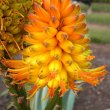
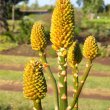
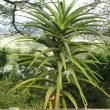
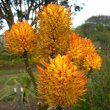
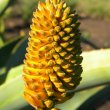
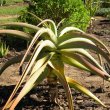
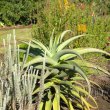


Discuss this plant
Share knowledge, ask a question or give an experience.